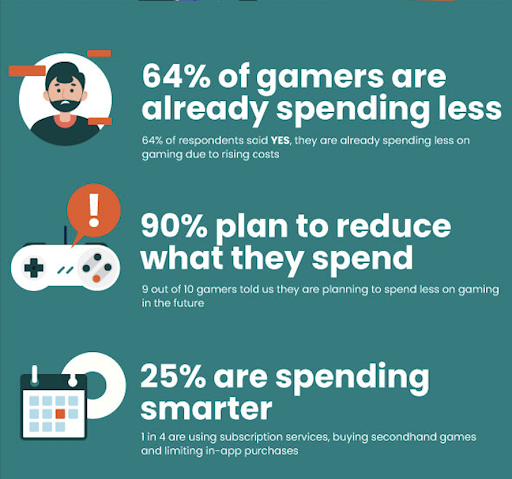For all the talk about the video game industry being recession-proof, there’s no getting around the fact that the mobile gaming market is in a downturn.
As games analyst firm Newzoo points out, 2022 was a corrective year for the global gaming market as spending declined following two years of lockdown-fueled growth.
The outlook is less than rosy. One-third of the global economy is expected to be in a recession in 2023. Soaring fuel costs and higher interest rates are among the factors contributing to the cost of living crisis in various parts of the world.
As global gaming revenue declines, we wanted to know how much of an impact the cost of living crisis is having on gamers. So we asked them.
About this poll
PickFu polled 754 U.S.-based gamers in August 2022 about the impact of cost of living increases on their video game spending.
According to Statista, the average console gamer spends around $84 a month on video games. Does having less money in their pockets affect their relationship with gaming? Has it led to a change in their gaming habits? Or are they continuing to spend on gaming over other forms of entertainment?
Here’s what gamers told us.
Key finding: Two-thirds of gamers are spending less on video games
Regardless of age, gender, education, or annual income, the cost of living crisis is affecting players’ spending across the board, our poll found.
64% of gamers said they have less money to spend on video games. As a result, they’re buying fewer video games.
“I was already living on a pretty tight budget before everything became more expensive. Now, unfortunately, we’ve had to cut back on a lot of things. Spending on video games and related subscriptions aren’t an option for us right now,” wrote a 45-to-54-year-old female respondent who identifies as a daily mobile gamer.
When asked about their future spending plans, 90% said they planned to spend less on video games.
“I plan to decrease the amount I spend and will only buy games on sale. The price of everything has gone up and video games seem like a frivolous and easy expense,” said a male respondent, a daily mobile gamer in the $101k+ income range.
These sentiments are in line with figures from the NPD Group showing a 13% decline in U.S. consumer spending on game products in the second quarter of 2022.
“We have begun to spend less on video games. With the increase in cost of groceries and gas, we need to prioritize our bills. We plan on trying to come up with side hustles so that our quality of life can remain the same. But for now, we have decided to cut back on the ‘fun things’ in life.”
Female, White, 25-34, daily mobile gamer, $101k+, married
The average gamer in the U.S. plays more than 7 hours of games each week, or 370 hours per year. That number is likely to drop as gamers choose to skip the latest releases or spend their leisure time in other ways.
One respondent, a 35-to-44-year-old man making more than $101,000, gave two reasons for cutting back on his gaming spend.
“One, my money now has to be allocated more towards food and money. Two, I have been working a lot more extra shifts at work to help combat the increases, giving me less time to play,” he wrote. “I can’t in good faith spend extra money on a video game that will tighten our food budget as well taking what little bit of time I have at home away from my family by playing video games.”
Key finding: Gamers are spending smarter on video games
Not only are gamers spending less because of rising costs, but they’re also changing their playing habits, our survey found.
One-quarter of respondents are using more subscription-based gaming services, buying more pre-owned games, or limiting their in-game purchases.
“I have limited myself to sales like Steam’s Summer Sale to save money. I have also halted purchasing games for my console as they are never on sale for a good price,” wrote one respondent (male, age 25-34, $61-100k income).
Rather than paying full price to play a game at launch, gamers are opting for free-to-play titles and using other cost-saving strategies.
“I try to buy only games I am going to get a lot of mileage out of, or I try to buy cheaper indie games that won’t break the bank. Everything has to be taken into account, and currently groceries and electricity are costing me more, so I have to cut back elsewhere,” said another male respondent, age 35-44, $31-60k income.
“I plan on decreasing the amount of money I spend but not the amount of games I buy. I will simply buy used physical games on the secondary market such as eBay or other local shops.”
Male, Asian, 35-44, daily mobile gamer, $61-100k income, married
With so many access points to video games, whether through subscription-based services like Xbox Game Pass or via free downloads in the iOS and Google Play Stores, gamers seem to be looking for and taking advantage of ways to save money.
Indeed, non-mobile subscription content was the only video game category that saw an increase in spending in the second quarter of 2022, according to the NPD Group.
Given that free-to-play games generate about 85% of the gaming industry’s total revenue through in-app purchases, it will be interesting to see how the industry responds to this shift in gamers’ spending habits.




